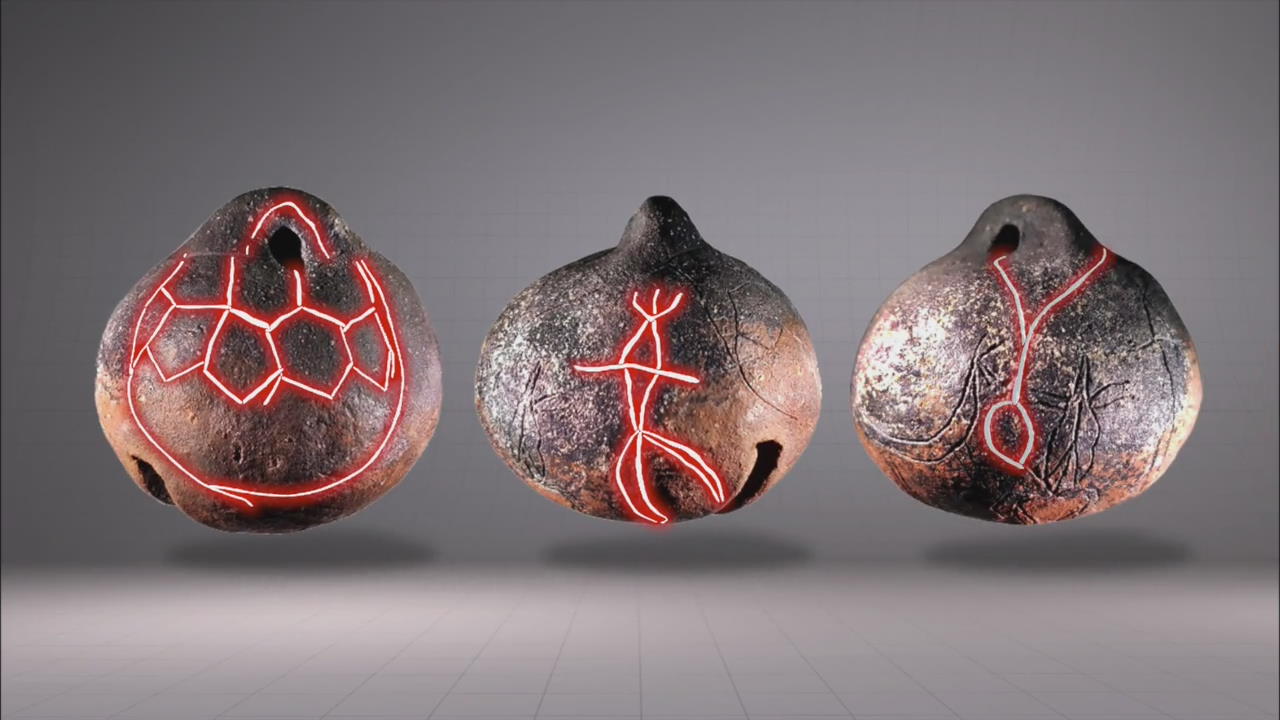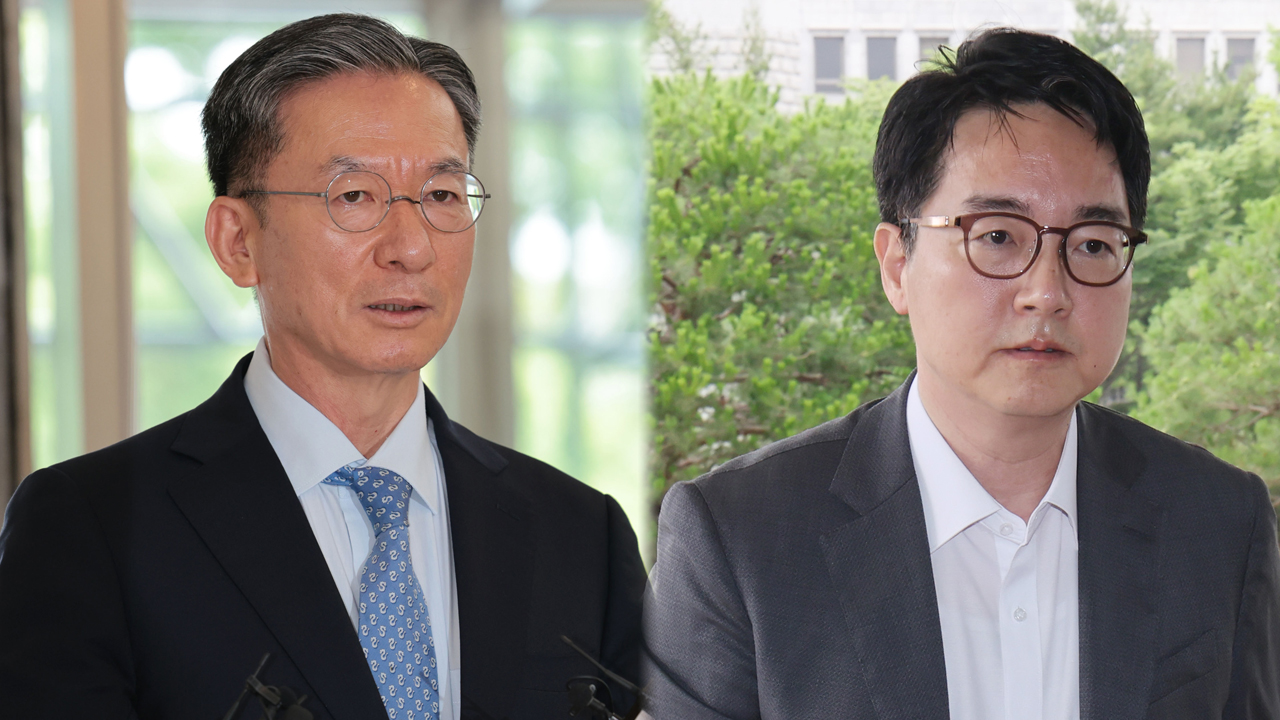Newly Discovered Relics
입력 2019.03.21 (15:20)
수정 2019.03.21 (15:24)
읽어주기 기능은 크롬기반의
브라우저에서만 사용하실 수 있습니다.
[Anchor Lead]
The ancient folk song "Gugija" is known to be about the founding of the Gaya confederacy, an ancient kingdom on the Korean Peninsula. Relics that are presumed to be depicted in the song have been found recently in one of the Gaya tombs in Goryeong, Gyeongsangbuk-do Province.
[Pkg]
This stone tomb presumably dates back to the Great Gaya period of the late 5th century. Some interesting relics have been recently found in the tomb measuring 1.6 meters long and 0.4 meters wide. They are earthen bell rattles. When viewed through a microscope, some of the rattles were found to have patterns reminiscent of a turtle shell. The discovery reminds scholars of the turtles mentioned in the ancient folk song "Gugija" about the founding of the Gaya confederacy. Other engravings on the bell rattles include a picture of a man wearing a crown and a sack containing golden eggs. Legend has it that the Gaya confederacy was founded when six kings were born from the golden eggs.
[Soundbite] Bae Sung-hyuk(Daedong Cultural Property Research Center) : "We have found that the relics have something to do with the historic events described in ‘Memorabilia of the Three Kingdoms’ and ‘Record of the State of Garak’, such as the one about the gold sack."
The excavators of the relics say it's the first discovery of cultural assets related to the Gaya legend. But it's still unknown who the tomb belongs to and if the patterns on the excavated relics are identical with the objects mentioned in the Gaya legend.
The ancient folk song "Gugija" is known to be about the founding of the Gaya confederacy, an ancient kingdom on the Korean Peninsula. Relics that are presumed to be depicted in the song have been found recently in one of the Gaya tombs in Goryeong, Gyeongsangbuk-do Province.
[Pkg]
This stone tomb presumably dates back to the Great Gaya period of the late 5th century. Some interesting relics have been recently found in the tomb measuring 1.6 meters long and 0.4 meters wide. They are earthen bell rattles. When viewed through a microscope, some of the rattles were found to have patterns reminiscent of a turtle shell. The discovery reminds scholars of the turtles mentioned in the ancient folk song "Gugija" about the founding of the Gaya confederacy. Other engravings on the bell rattles include a picture of a man wearing a crown and a sack containing golden eggs. Legend has it that the Gaya confederacy was founded when six kings were born from the golden eggs.
[Soundbite] Bae Sung-hyuk(Daedong Cultural Property Research Center) : "We have found that the relics have something to do with the historic events described in ‘Memorabilia of the Three Kingdoms’ and ‘Record of the State of Garak’, such as the one about the gold sack."
The excavators of the relics say it's the first discovery of cultural assets related to the Gaya legend. But it's still unknown who the tomb belongs to and if the patterns on the excavated relics are identical with the objects mentioned in the Gaya legend.
■ 제보하기
▷ 카카오톡 : 'KBS제보' 검색, 채널 추가
▷ 전화 : 02-781-1234, 4444
▷ 이메일 : kbs1234@kbs.co.kr
▷ 유튜브, 네이버, 카카오에서도 KBS뉴스를 구독해주세요!
- Newly Discovered Relics
-
- 입력 2019-03-21 15:20:57
- 수정2019-03-21 15:24:10

[Anchor Lead]
The ancient folk song "Gugija" is known to be about the founding of the Gaya confederacy, an ancient kingdom on the Korean Peninsula. Relics that are presumed to be depicted in the song have been found recently in one of the Gaya tombs in Goryeong, Gyeongsangbuk-do Province.
[Pkg]
This stone tomb presumably dates back to the Great Gaya period of the late 5th century. Some interesting relics have been recently found in the tomb measuring 1.6 meters long and 0.4 meters wide. They are earthen bell rattles. When viewed through a microscope, some of the rattles were found to have patterns reminiscent of a turtle shell. The discovery reminds scholars of the turtles mentioned in the ancient folk song "Gugija" about the founding of the Gaya confederacy. Other engravings on the bell rattles include a picture of a man wearing a crown and a sack containing golden eggs. Legend has it that the Gaya confederacy was founded when six kings were born from the golden eggs.
[Soundbite] Bae Sung-hyuk(Daedong Cultural Property Research Center) : "We have found that the relics have something to do with the historic events described in ‘Memorabilia of the Three Kingdoms’ and ‘Record of the State of Garak’, such as the one about the gold sack."
The excavators of the relics say it's the first discovery of cultural assets related to the Gaya legend. But it's still unknown who the tomb belongs to and if the patterns on the excavated relics are identical with the objects mentioned in the Gaya legend.
The ancient folk song "Gugija" is known to be about the founding of the Gaya confederacy, an ancient kingdom on the Korean Peninsula. Relics that are presumed to be depicted in the song have been found recently in one of the Gaya tombs in Goryeong, Gyeongsangbuk-do Province.
[Pkg]
This stone tomb presumably dates back to the Great Gaya period of the late 5th century. Some interesting relics have been recently found in the tomb measuring 1.6 meters long and 0.4 meters wide. They are earthen bell rattles. When viewed through a microscope, some of the rattles were found to have patterns reminiscent of a turtle shell. The discovery reminds scholars of the turtles mentioned in the ancient folk song "Gugija" about the founding of the Gaya confederacy. Other engravings on the bell rattles include a picture of a man wearing a crown and a sack containing golden eggs. Legend has it that the Gaya confederacy was founded when six kings were born from the golden eggs.
[Soundbite] Bae Sung-hyuk(Daedong Cultural Property Research Center) : "We have found that the relics have something to do with the historic events described in ‘Memorabilia of the Three Kingdoms’ and ‘Record of the State of Garak’, such as the one about the gold sack."
The excavators of the relics say it's the first discovery of cultural assets related to the Gaya legend. But it's still unknown who the tomb belongs to and if the patterns on the excavated relics are identical with the objects mentioned in the Gaya legend.
이 기사가 좋으셨다면
-
좋아요
0
-
응원해요
0
-
후속 원해요
0















![[단독] 한강버스 운항 두 달 남았는데…일부 공정률 ‘절반 이하’](/data/news/2025/07/01/20250701_LmwC7h.jpg)

이 기사에 대한 의견을 남겨주세요.